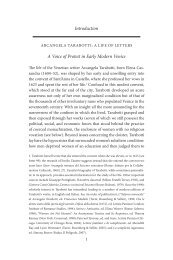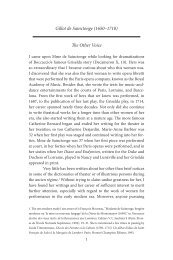Excerpt - Iter: Gateway to the Middle Ages and Renaissance
Excerpt - Iter: Gateway to the Middle Ages and Renaissance
Excerpt - Iter: Gateway to the Middle Ages and Renaissance
Create successful ePaper yourself
Turn your PDF publications into a flip-book with our unique Google optimized e-Paper software.
22 Edi<strong>to</strong>r’s Introduction<br />
stability implied by <strong>the</strong> Neopla<strong>to</strong>nic goal of a perfect union in love, or<br />
by any one-dimensional account of <strong>the</strong> poet’s persona.<br />
Poem 6 also revolves around <strong>the</strong> poet’s identity <strong>and</strong> voice. As<br />
Saulnier points out, most nineteenth-<strong>and</strong> early twentieth-century<br />
anthologies include this epigram in <strong>the</strong>ir limited selection of Du<br />
Guillet’s poetry as an example of <strong>the</strong> modest voice of <strong>the</strong> young poet,<br />
student of Scève, largely because of <strong>the</strong> <strong>to</strong>ne of its opening lines: 52<br />
With this dizain I show myself clearly<br />
Not knowing how <strong>to</strong> honor all your virtues<br />
Beyond <strong>the</strong> will—a weak excuse, merely:<br />
Par ce dizain clerement je m’accuse<br />
De ne sçavoir tes vertus honnorer,<br />
Fors du vouloir, qui est bien maigre excuse: (6:1–3)<br />
Even in this humbling comparison, however, <strong>the</strong> poet distinguishes<br />
herself from <strong>the</strong> lover, insisting on <strong>the</strong> differences that separate her from<br />
his eloquence. Her use of <strong>the</strong> humility <strong>to</strong>pos allows her simultaneously<br />
<strong>to</strong> proclaim her inadequacies <strong>and</strong> <strong>to</strong> suggest quite <strong>the</strong> opposite. The<br />
voice of <strong>the</strong> young woman explains that she could give him <strong>the</strong> praise<br />
that is his due if she had his power, which comes through learning:<br />
Lend me, <strong>the</strong>n, your eloquent learning <strong>to</strong><br />
Praise you, in just <strong>the</strong> same way you praise me.<br />
Preste moy donc <strong>to</strong>n eloquent sçavoir<br />
Pour te louer ainsi, que tu me loues. (6:9–10)<br />
Although he infuses her with his knowledge, no poet can sing <strong>the</strong><br />
admiration of ano<strong>the</strong>r without an identity <strong>and</strong> a voice strong enough<br />
<strong>to</strong> offer that praise. Fur<strong>the</strong>rmore, <strong>the</strong>se verses call attention <strong>to</strong> <strong>the</strong><br />
female poet’s need of her beloved’s learning in order <strong>to</strong> speak within<br />
a male mode of lyric discourse. 53<br />
He represents <strong>the</strong> essence of <strong>the</strong><br />
patriarchal conventions that dominated literary production in France<br />
<strong>and</strong> Italy during <strong>the</strong> <strong>Renaissance</strong>. A woman wishing <strong>to</strong> enter in<strong>to</strong> this<br />
52. “Etude,” 111.<br />
53. For fur<strong>the</strong>r discussion of poem 6, see <strong>the</strong> section on dialogue <strong>and</strong> imitation below.




